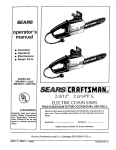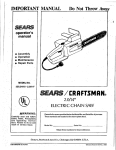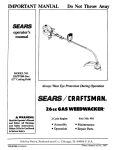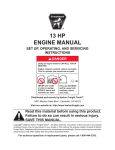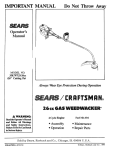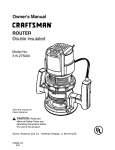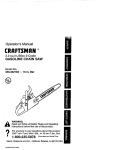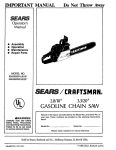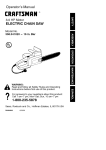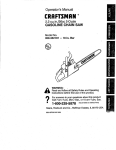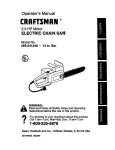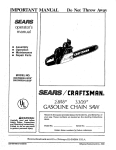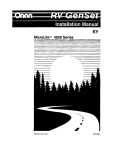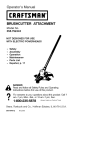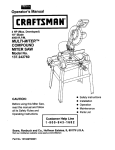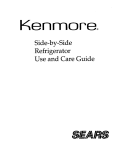Download Craftsman 358.34120 Operator`s manual
Transcript
IMPORTANT
MANUAL
DoNot
Throw Away
°
operator's
manual
•
•
•
•
Assembly
Operation
Maintenance
Repair Parts
MODEL
358.34120"
NO.
2.0/12"
358.34150 - 2.0/14"
2.0114"
P.S.
@/____,_S
/ CRI:1FTSMRN®
.2.0/12".. 2.0/14" 2.0/14"-ES.
ELECTRIC CHAIN SAWS
AkWAR N! N G:
read and follow
Safety Rules, PreQautions
and Operating "lnstruc.
tions. Failure to do so can
result in serious personal
injury.
,
u
i
.
,ll,
Record in the space provided below the Model No. and Serial No. of
your saw. These numbers are located on the starting instructions
decal.
Model No.
Serial No.
Retain these numbers for future reference.
Sears, Roebuck
530.067381-3-21088
and
Co., Chicago,
Ill 60684
U.S.A.
• -_©S_'slko_b.ck_a Coi_1988
FULL 1 YEAR-WARRANTY
ON ELECTRIC
(Excluding
CHAIN
SAW
Bar & Chain)
For one yearfrom date of purchase, Sears w_ltrepairdefects in material or wo_manshtp in _is 2X) Electric Chain Saw at no charge,
This warrantyexCludes b_r & chain, whic_hare expendable parts and become wornduring normaluse.
Ifthis2J0 Efectdc Chain Saw is usedforcommerciai or rentalpurposes,thiswarrantyappliesforonly30 days fromdateofpurch ase_WARRANTY
S ERV{CE ISAVAI/_ABLEBYRETUR NING THE CHAIN SAWTO THE NEAREST SEARS SERVICE C ENTER/DEPARTMENT INTHE U NITED
STATES.
Th_Swarranty gives you specific legal dghts,and youmay also haVe other rightswhichvary from stateto state.
Sears, Roebuck and Co., Sears Tower, Dept. 698/731A, Ctdcago, IL 60684
TABLE
OF CONTENTS
Specifications ...............................
2
SPECIAL SAFETY SECTION ....................
5
Know Your Chain Saw ........................
6
Preparing Your Saw For Use ...................
7
A. Getting Ready ...............
. ...........
7
B. Power Source and Extension Cord--... -::: .... 7
C. Attaching the Bar and Chain ................
8
D. Chain Tension ............
: ..............
8
E. Bar and Chain Lubricant.....................
9
Using Your Saw .............................
10
A, Control Devices ..........................
10
B. Pre-Operation Checks .... ".............
... 10
C. Starting and Stopping the Saw .............
10
Using the Power Sharp _ System ...............
11
Types of Cutting ............................
13
A. Basic Cutting Technique ..................
13
B. Tree Felling Techniqqes-. .................
13
C. Bucking ...............................
15
D. Debranching and Pruning .............
,. ,... 16
Maintenance ...............................
17
A. Cleaning the Saw ............
: ..........
17
B. Guide Bar and Chain ....................
17
C. Sprocket ..............................
19
D. Storage ...............................
20
E. Maintenance Accessor'_s .................
20
F. Trouble Shooting Chart ...................
21
Repair Parts List .............................
22
Quick Reference Page .......................
27
SPECIFICATIONS
MODEL
............
.....
_._.#120(__0/1_,
)
_,_4Is0(_.o/t4,)
110-120Vo_AC
_Hz
POWER SUPPLY
_1"t0.120
Vo_tSAC
50-60Hz
110-120Vo!_sAC
50-60 HZ
I,. -EDCu.R
MAXIMUM MOTOR OUTPUT
2.0 Horsepower _
.......................2.0Hopepower
0irect Ddve
; SPROCKETiDRrv_
.......................
3i8P_ch, LowProfile
Direct Ddve
...........
3/8 Pitch, LowP_fi|e
2,0 Horsepower
6 Tooth-SlipCJutch
CHNN-- Oregon
®
Non-ChromeCuttem .
Non,ChromeC_l_rs
Rep_tcemer_tStock No. 71,_;23
Replacement Stock No, 71-36'/7
3/8 Pitch, Low Pmt_e
PowerSharp _ Chromed Cutters
Repla_e,'TmntStock No..7/-3618
GUIDE BAR -- LO-K3C{_
12" Non-Armored T_ Nose
Replacement Stock No. r44244
14" Notl-Armomd Tip Nose
Rep_._t
'_0 _ No. 7t -36365
t4 • Sprocket Nose
Repl_ceme_ Stock NO.
OILER
M_nual
CHAtN SHARPENING
ManueJ
Manual
................
:Manua!
Manual
......] PowerSharp ® System
Stub Handle
Power
Sharp.
Lock-out Button
Oiler Activator
Powe!Cord
=Oil Level
Indicator
Motor
Housing
i
"
i
i,
SPECIAL
'i
GUARD
iiii
i
iiiiiiiiiiiiiiiiiii
iiiiiii
SAFETY
................
I11
AGAINST
IIIH
iiiiiii
i
IIIIIIIII
i
IIII
i :i
L_,
iiii
k
,,
iiiiiiiiiii
ii
i
ii
i J
I i
SECTION
Ill
II
IIIIIIIIIIIIIIIIIIIIIIIII
I
I
I
I
I
I
III
III
KICKBACK
Kickback is a dangerous reaction that can lead to
serious injury. Do not rely only on the safety devices
provided wtth your saw. As a chin saw user, you must
take special safety precautions to help keep your
cutting jobs free from accident or injury.
_k KICKBACK WARNING
Kickback can occur when the moving chain contacts
an object at the upper portion of the tip of the guide bar
or when the wood closes in and pinches the saw chain
in the cut. Contactattheupperportionofthetipofthe
guidebarcan cause the chainto dig intothe object and
stop the chain for an instant. The result is a h'ghtning
fast, reverse reaction which kicks theguide bar up and
back toward the operator, ff the saw chain is pinched
along the top of the guide bar, the guide bar can be
dttven rapidly back towardthe operator. Either ol_these
reactions can cause loss of saw control which can
result in se,'lous injurj.
KICKBACK
PATH
1. Recognize that kickback can happen. With a basic
understandingofkickback, you can reduce theelement of surprise which contributes to accidents.
2. Never let the moving chain contact any object at
the tip of the guide bar. Figure 1.
3. Keep the working area free from obstructions
such as other trees, branches, rocks, fences,
stumps, etc. Figure 2. Eliminate or avoid any
obstructionthat your saw chain could hit while you
are cutting through a particular log or branch.
4. Keep your saw chain sharp and properly
tensioned. A loose or dull chain can increase the
chance of kickback. Follow manufacturer's chain
sharpening and maintenance instructions.Check
tension at regular intervals with the motorstopped,
neverwiththemotor running.Makesurethatbarclamp
nuts are securelytightenedafter tensioningthe chain.
5, Begin and continue cutting only with the chain
moving at full speed. If the chain is moving at a
slower speed, there is greater chance for kickback
to o_ur.
6. Cut one log at a time.
7. Use extreme caution when reentering a previous
cut.
8."Do not attempt plunge cuts.
9. Watch for shiffing logs Orother forces that could
close a cut and pinch or fall into the chain.
10. Use the Reduced-Kickback Guide Bar and LowKickback Chain specified for you r saw.
Figure 1
AVOID
OBSTRUCTIONS
CLEARTHE
WORKINGAREA
•Figure 2
KEEP A RRMGRIP
WITH BOTH HANDS
WITH LEFT THUMB
GRIP
INCORRECT
GRIP
CONTROL
1. Keepa good firm grip on thesaw with both hands
when the motoris running and don't let go. Figure
3. A firm grip can neutralize kickback and help you
maintain controlof the saw. Keep the fingersof your
lefthandencirclingand yourleftthumb underthefront
handlebar.Keepyourrighthandcompletelyaroundthe
rear handle whether you are right handed or left
handed_ Keep your left arm straight with the elbow
locked.
2. Never reverse right and left hand positions. Figure3.
3. Stand with your weight evenly balanced on both
feet.
4. Stand slightly to the left side of the saw, to keep
your bod_ from being in a direct line with the cutting chain. Figure 3.
5. Do-not overreach. YouCouldbedrawn or thrownoff
balance and lose control of the saw.
6. Do not cut above shoulder height. It is difficultto
maintain control of the saw above shoulder height.
.5
CORRECT
MAINTAIN
CORRECT
POSITION
Figure 3
/,
•
.
iii i
iiiiii
,
i
SPECIAL
,1111 I
i i
iiiiiiiiiiiiiiiiiii
i
i
SAFETY
i iI
i
ii
i
iiiiiii i
SECTION
i
mm,
wml,,i
m i
im i i
,i i IH,HIH ,11
II tll
IIIIIII
(continued)
ml,II I I
i
H
iml=l, i= i.
ill
,mHIml
.H
"
I
_kWARNING
Because a c hain saw is a high-speed wood-cutting tool, Special safety precautions must
beobserved to reduce the rlskof accidents. Careless or Improper use can cause serious
injury.
:t Do not handle or operate a chain saw when you
are fatigued, ill, or upset; or if you have taken
alcohol, drugs or medication. You must be in good
physical condition and mentally alert. Chain saw
work is strenuous. If you have any condition that
mightbe aggravated bystrenuouswork,check with
your doctor before operating a chain saw.
SNUG
FITTING
CL_
DUTY GLOVES
.
SAFETYCHAPS
.
SAFETY
SHOES
""\m!l
KNOW
YOUR
Do not attempt to use yoursaw during bad weather
conditions suchas strongwind,electricarstorms,rain,
snow,etc.,or at night.....
P_n your sewing opemtions c_l!y
in advance.
Do not startcutting until youhave a clear work area,
secure footing, and ifyou are felling trees, a planned
retreat path.
lie
Figure4
6.. Avoid accidental starting. Always unplug the saw
when not in use.
SAW
AVOID REACTIVE
1. Read your Operator's Manual carefully until you
completelyunders_ndandfollowallsafetyinstructions
and operatingins_nJctions
beforeattemptingtooperate
the unit.
2. Restrict the use of your saw to adult users who
underaandand_k_vthesef_rule_ _
and
operating instructionsfound in this manual
FORCES
Pinch-Kickback and Pull-in occur when the chain is
suddenly stopped by being pinched, caught, or by
contacting a foreign object in the wood. Thisresultsin
reversalof the chain force being used to cut woodand
causesthe sawto move inthe opposite directionofchain
rotation.Pinch-Kickback drivesthe saw straight back
towardtheoperator.Pull-in pulls the saw away from the
operator.Eitherreactioncan resultinthe lossofcontroland
sedousinjury.
To avoid Pinch-Kickback:
PLAN
AHEAD
,
1.
Wear protective gear.Always use
steel-toed safety footwear with nonslip soles; snug-fitting clothing with
Jm_rorcod cutting resistant inserts;
heawAuty non-slipgloves;eye proCecfJon
such.as nonfogging, vented gogglesor face screen; an approved
safety hardhat;and soundbarriers--ear p_ugsor muffte_ toprotectyourhearing,Regularusersshouldhave
hearing checked regularly as chain saw noise may
damage hearing.
2. Keep children, bystandem, and animals out ofthe
work area-- aminlmum of 30 feet (10 meters). Do
not allowpeople or animalsto be near the chainsaw
when startingoroperating the chain saw.
4
.
Be extremely aware of situations or obstructions
that cancause matedal topinchthetopofor otherwise
stopthe chain.
Do not cut more than one log at a time.
3. Do not twist the saw as the bar iswithdrawn froman
under-cutwhen bucking.
To avoid Pull-in:
• 1. Alwa_beglncutt/ngwlththecl_inmovl_3atfull
speed and the saw frame against the wood.
2. Use wedges made of plastic or wood, (never of
metal)to hold the cut open.
SPECIAL
......
III
OPERATE
.
SAFETY SECTION
. I
II
II
I
II I
m
(continued)
I IIIII
II
El
I
I
II
IIIIIIIII
YOUR SAW SAFELY
1. Do not operate a chain saw that is damaged,
improperly adjusted, or not completely and
securely assembled.
2. Do not use the saw if the trigger switch does not
turn the unit on and off properly. Repairstothe trigger switch must be made by your Sears Service
Center.
3. Do not operate the saw from a ladder or in a tree.
4. Position all parts of your body to the left of cut
when the motor is running.
5. Cut wood only. Do notcut metal, plastics,masonry,
non.vKx_ buildingmaterials,etc. Do notuseyoursaw
topryor shoveawaylimbs,rootsor otherobjects.
6. Make sure the chain will not make contact with
any object before starting the motor. Never try to
start the saw when the guide bar is in a cut or kerf.
7. Use extreme Caution when cutting small size
brush and saplings. Slender materialcan catch the
saw chain and be whipped tov;ardyou or pul!youoff
balance.
8. Be alert for springback when cuttinga limb that is
under tension to avoid being struck bythe limb or saw
when "the tension in the wood fibers is released.
9. Do not force the saw through a cut. Exert light
pressure only. Pressure on the saw at the end of a
cut could cause loss of control when the Cut is
completed.
10. Avoid body contact with the chain anytime the
saw is plugged into a power source. The chain will
continue to move for a shorttime afterthe trigger is
released.
11. Avoid dangerous situations. Do notexposethe saw
to rain, or use in damp, wet, gaseous, or explosive
locations.
I2. Unplug the power connection when the saw is not
in use.
3, Keep chain and guide bar clean and properly
lubricated.
4. Keep oii cap, screws and fasteners tight.
5. Keep the handles dry, clean, and free of oil
6. Stop the saw if the chain strikes a foreign object.
Check for alignment, binding,breakage,and mountingof moving partsand anyotherconditionthat may
affectthe operationof the unit.Check guardsand all
other pads to see if each willoperate properly and
perform its intendedfunction. Any part that is damaged should be properly repaired or replaced by
using the instructionsin this manual or by seeing
your Sears Service Center.
7 Be certain the saw chain stops moving when the
trigger switch is released.
8. Make certain that alrhand tools are removed from
the saw before connecting the saw to the power
source.
9. Never modify your sawin any way.Use onlyattach.=
ments supplied or specificallyrecommended by the
manufacturer.
10. Always replace the handguard immediately if it
becomes damaged,
broken or otherwise
removed.
CARRY AND SI"ORE
YOUR SAW SAFELY
SAW IN
ORDER
I. Unplug the saw before servicing or changing
accessories.
2. Have all chainsawservice,(other than theservice
described in the maintenance section of this
manual) performed byyour Sears Service Center.
Never carry yoursaw while climbing. Both hands
are needed for safe climbing,
.
Carry the unit unplugged, by the front handle,
finger off tWetrigger switch, and with the guide
bar and chain to the rear.
3. Carry the saw with guide bar and chain covered
by the scabbard.
4.
MAINTAIN
YOUR
GOOD WORKING
o
Before transporting in any vehicle or storing in
any enclosure, allow yoursaw to cool completely,
cover the bar and chainand propedysecure to avoid
turnover or damage.
5. Drain oil tank before storing your saw for 30 or
more days.
6. Store in a dry area out of the reach of children.
NOTE
Exposuretovibrations throughprolonged use of this tool may produce Whitefingerdisease (Raynaud's phenomenon)
This phenomenon reduces the hand's ability to feel and regulate temperature, produces numbness and burning
sensations and can cause nerve and circulation damage and tissue necrosis.
An anti-vibration system designed to reduce engine vibration is recommended for those using power tools on a
regular or sustained basis. An anti-vibration system does not guarantee the avoidance of Whitefinger disease,
Continual and regular users must monitor closely theii- use of power tools and physical condition.
THIS CHAIN SAW IS FOR OCCASIONAL
USE ONLY.
Notice:
Refer to the Code of Federal Regulations,Section 1910.266(5); 2.5.1 ofAmerican NationalStandard Safety Requirements for Pulpwood Logging,
ANSI. 03.1-t978;
and relevant
state safety
codes
when using a chain saw for logging
•
•
.
•
•
. , .
,
•
purposes.
KNOW
YOUR CHAIN SAW
A. INTRODUCTION
,,L
..........
_
, ,,,,,
• Yoursaw has been designedwith safety in mind and
includes the following features as standard
equipment:
Reduced-KickbackGuide Bar (Lo-Kick_)
m Low-KickbackChain (Xtra-GUARD®)
Handguard
AWARNING
The following features are included on your saw to
help reduce the hazard of kickback. However, such
features will not totally eliminate this dangerous maction. As a chain saw user, do not rely only on safety
devices. You must follow all safety precautions, instructions and maintenance in this manual to help
avoid kickback and other forces which can result in
serious injury.
B. KICKBACK
SAFETY' FEATURES
-- Reduced-KJckbackGuide Bar,designedwithasmal|
radiustipwhichreducesthesfzeofthe kickbackdanger
zone on the bar tip. Figure 5. A Reduced Kickback
Guide Bar is one which has been demonstrated to
significantlyredu(/e the number and seriousnessof
kickbacks when tested in accordancewith the safety
requirementsfor gasolinepoweredchainsawsas set
by the American National Standards Institute, Inc.
Standard B175.1- 1985.
_--Low-Kickback
Chain, designed with a contoured
depthgauge andguardlinkwhichdeflectthekickback
force and allowwood_ograduallyride intothe cutter,
Figure5. LowKickback Saw Chain ischain whichhas
met the kickbackperformancerequirementsof ANSI
B175.1 (Safety Requirementsfor Gasoline-Powered
Chain Saws) whentestedon a representativesample
ofchainsaws below38 cubicinch displacementspecified in ANSI B175.1.(American .National Standards
In_tute, inc., StandardBi75.1 - 1985).
--
Handguard, designed toreducethe chanceofyourleft
handcontactingthe chainifyourhandslipsoffthefront
handlebar.
Figure 5
C, DOUBLE
INSULATION
Your Chain Saw is double insulated to help protect
against electric shock. A double insulatedt0ol isconstrucl_dthroughoutwith two separate "layers" ofelectrical insulationor one double thickness of insulation
between the operatorand the electrical system of the
toot.
Toolsbuiltwith this insulation system are not intended
to be grounded. As a result, the extension cord used
with yoursawcanbe plugged intoany conventional 120
volt electrical outletwithout concern for maintaining a
ground connection.
Safety precautions must be observed when
operating any electrical tool. The double insulation
system only supplies added protection against injury
resulting from a possible electrical insulation failure
within the saw.
D. CARTON
CONTENTS
After you unpack the carton:
1. Check the contents against the list below.
2. Examine the items for damage.
3. Notifyyour Sears store immediately ff a part ismissing or damaged.
NOTE: A rattle-like noise in a powerhead with an
empty oil tank is a nori-nal_ondition caused by the
filter moving against the wall of the tank.
-- Position of front and rear handlebars, designedwith
distance between handles which provides better
balance and resistanceif kickbackoccurs.
_kWARNING
Do not operate the chain saw unlessthesafety devices
or their specified replacements are properly installed
and maintained according to the instructions in this
manual. Do not useanyotherguide barand chain combination that is not equivalent to the original equipment
or not certified to comply with ANSI B175.1. Failure
to follow these instructions can result in serious
injury.
KEY NO.
1
2
3
4
CARTON CONTENTS:
Powerhead
Guide Bar
Scabbard
Chain
Operator's Manual (Not Shown)
QTY,
1
1
1
1
1
i i
im
ii
"
....
I............
i;
, ....
PREPARING
,,,, ,,,ll
i
YOUR SAW FOR USE
iiiiiiiiiiii
A. GETTING
READY
I. READ YOUR OPERATOR'S MANUAL CAREFULLY.YourOperator'sManual has been developed
to help you prepare yoursaw for use and to understand itssafe operation. Iris importantthat you read
yourmanuat completely tobecome familiar withthe
unit before you begin assembly.
.......
2. HAVE THE FOLLOWING AVAILABLE:
a. Protective Gloves.
b. ½ inch wrench or equivalent.
c. Screwdriver
d. Bar and Chain Lubricant (see page 9).
J,,_,,,,,i
i illl iii ill i ill
,,,,,,,,,,,,,,,
ii
•
B. POWER
SOURCE
AND EXTENSION
ii iiii II
i
iii
ii
CORD
1. POWER SOURCE
3. IMPORTANT POINTS
a. Secure, the tool cord to the extension cord as
shown in Figure 7 to prevent disconnection,
Use only an A.C. voftagesupply identica! to that
shown on the name plate of the saw to power this
chain saw.
b,
_k WARNING
All elactdcal repairs to this saw, including housing,
switch, motor, etc., must be diagnosed and repaired by
your Sears Service Center or nearest Sears store.
Failure to do so can cause the double insulation
construction to become ineffective and result in
serious injury.
Do not abuse cords. Never carry saw by the
powercordor yank ittodisconnect,Keeptoolcord
and extension cordawayfrom heat, oil, and sharp
edges.
c. Guard against electric shock. Avoidbody contact with any grounded conductor,such as metal
pipes and wire fences.
d. Avoid entanglement. Keep cords clear of
operator, sawchain, and branches at all times.
e. Avoid dangerous situations, Donor exposethe
saw to rain, or use in damp, wet, gaseous, or
explosive locations.
2. EXTENSION CORD
a. The extension cord used to reach the power
source must be:
f. inspect extension cords before each use.
Replace before using the saw if damaged,
1.) Specifically marked as suitable for outdoor
use. The suffix,W-A, must be includedon the
cord label.
g, Inspect chain saw cord before .eachuse. Do not
use the unit with a damaged cord. Take the unit
to a Sears Service Center. for repairs.
2,) Heavyenough to carry'the current from the
power source to the distance at which the
saw is to be used. Otherwise, loss of power
and overheating can occur causing damage
tothe unit. Refer to Figure6 for minimum wire
gauge recommendations.
SECURE TOOL CORD TO
3.) In good condition. Cord insulation must be
intact with no cracks or deterioration. Plug
connectors must be undamaged.
EXTENSION CORD._
b. Suitable extension cords are available at your
Seam Retail or Catalog Store.
MINIMUM WIRE GAUGE
RECOMMENDATIONS
I
i
AMP
VOLTS
25 FT.
50 FT.
100 F_.
12
120
16
A.W.G.
14
A.W.G.
10
A.W.G.
.
t
Figure 7
]
r
SAVE THESE INSTRUCTIONS
Figure 6
7
iii
¢, ATTACHING
THE BAR AND CHAIN
• Your saw is equipped with a Reduced-Kickback
Guide Bar and a Low-Kickback Chain.
e
Use only the Reduced.Kickback Guide Bar and
Low-Kickback Chain specified for your chain saw
m odel: when replacing these parts, See "Specifications;' page 2.
|CAUTION._ Wear protective gloves when handling or operating your saw, Thechain issharp and
can cut you even when it is not moving!
Avoid accidental starting. Always unplug the saw
from the power source before installing a bar and/or
l
AWARNING
chain.
Figure g
1, Remove the Bar Clamp Nuts & Bar Clamp
Housing,
2. Turnthe AdjustingScrew counterclockwise
to move
the AdjustingPin almostas Parasitwillgotothe rear.
Figure8.
3 Placethe Guide Bar on the saw byfittingthe long
slot in the Guide Bar over the two mountingstuds.
Figure 9,
NOTE: BesuretheGuideBar ispositioned
withthe
• roundhole belowthe largeslot,
4. Hold chain with cutters facing as shown
Figure 10.
CUTTERSMUST
FACE IN DIRECTION
OF ROTATION
Figure 10
in
FIT CHAIN
AROUND
SPROCKET AND
GUIDE BAR
5. Place the chain around the sprocket and fit the
drive Jinksinto the Guide Bar grooves-- first the
top and then the bottom groove. Figure 11.
6. Slide the bar forward and fitthe adjustingpin into
the round hold in the Guide Bar.
7. Hold the Guide Bar against the saw frame and
install the Bar Clamp Housing. Figure 12.
. ..
8, 'SecuretheBarClamp Housingwiththe BarClamp
Nuts untilfinger tighton/y.
Figure 11
9. Follow"Chain Tension"Instructionson nextpage.
,jr
TURN ADJUSTING
COUNTE
•
SECURE
BARCLAMP
HOUSING
SCREW
Figure 8
......BARCLAMP N_U.
1"S
0
Figure 12
,
r
_
......
-
.............
_!
IIIIFIIIIIIII
D. CHAIN
f
_IIIIILI
II
I
I
III
_llili
II
I
LIIIII
I
i
III
il
I
TtNSi0N
* Chain tension Is very important:
--A loose chain will wear the bar and itself.
--A loose chain can jump offthe bar while you are
cutting
-- A tight chain can damage the saw andlor break.
e The chain stretches dudng use, especlallywhen
new. Check tension:
-- each time the saw is'used
-- more frequently when the chain is new
--as' the chain warms up to normal operating
temperature.
Iipjiiiiiiiiiii
Iiiiiiiiiiiiiii
i
I,
,
,
II
, iiiii
i,
i
iiiiiiiiiii
*1 I
i iiiiii
• Chain tension is correct when the chain:
--can be lifted about 118"from the Guide Bar at a
point near the middle of the bar, and
--will move freely around the bar.
_WARNING
Avoid accidental starting. Always unplug the saw
from the power source before adjusting chain
tension.
• Chain tensioning procedure:
NOTE: The bardamp nutsmustbeno morethanfinger
tighttotensionthe chaincorrectly.
1. Hold the tip ofthe Guide Bar up and turn the Adjust. ing Screwclockwise just untilthe chain does not sag
beneath the Guide Bar.Figure 13.
.NOTE: Totighten tension, turnthe adjusting screw
clockwise _
.Toloosentension,turn the adjusting screw counterclockwise_.
2. Check the tension by liftingthechain from the Guide
Bar at the center of the bar. Figure 14.
3. Continue turning the AdjustingScrew until the tension is correct.
4. Hold the tip ofthe Guide Bar up and tighten the Bar
Clamp Nuts with a wrench.
5. Recheck tension.
E' BAR ANDCHAIN
OIL
II
III
II
III'1
• The guide bar and cutting chain require continuous lubrication in order to remain in operating
condition.
--- Lack of oil will quickly ruin the bar and chain.
-- Too little oil will cause overheating shown by
smoke comingfrom thechain and/or discoloration
of the guide bar rails.
• Use Sears Bar and Chain Lubricant #71-36554 to
fill the oil tank. Clean SAE 30W oil may also be
-used. Never use waste oi/for this purpose.
1. IMPORTANT POINTS
a. RI! the oil tank every time you use the saw.
See "Specifications" for oil cap location.
b. Wipe off surfaces be_reflliing with oil toavoid
sawdust ordebrisaccidentallyfallingintothetank
•and causing damage.
c. Use a funnel to fill the tank and wipe up all
spills. Do notuse the saw until itiswiped clean
and is completely dry from spilled oil.
d. Replace the oil cap securely to ensure proper operation of the oiler.
e. Check the otl level indicator frequentJyduring use. Locate the indicator in the saw frame
just below and behindthe front handte. Figure
15. If oil is not visible in the slot when saw is
upright on a level surface, the tank requires
filling.
f. Let saw stand unplugged for 15 minutes
before storing, It isnormal fora small amount
of oil todripoff the bar and chain when the saw
is not {n use. The excess oil should be wiped
from the saw before storing.
Figure 13
CHAIN, CAN BE
t
Figure 14
I
i
i
i [
....
i
i
ii
2. USING THE MANUAL OILER
Yoursaw isequipped with an oiler activatorwhich
manually supplies oil to the bar and chain.
The oiler activator must be used regularly andoften enough to maintain a thin film of oil on the
bar and chatn whlle the saw Is cutting. It is
recommended that the oiler activator be
operated six {6) times a minute and held for
approximately three (3) seconds each time It
is pressed.
a. Operate the oiler bypressingdown onthe oiler
activator with your right thumb. Figure 15.
b. Be surethat you continuetogrip handlesfirmly
while using the oiler activator.
Figure 15
•
"
i i
,i
=
"'='
"
'_1
,.......,
i
iii
a
• ,
I IIIII
II
=_1
II
USING YOUR SAW
A. CONTROL
DEVICES
Understanding the control devices on your saw is
an Important part of learning how to properly and
safely operate the unit. Figure 16.
FRONT HANDLE
OIL
ACTIVATOR
LOCKJOUT
3_
OIL
LEVEL
INDICATOR
REAR
HANDLE
JJ
B.
PRE-OPERATION
JU:L_L__ __
,
The Trigger Switch startsor stopsthe motorand is
located in the rear handle. The Trigger Switch is
designed to be used with the LockoutButton.
.
The Lockout Button is a controlfeaturedesignedto
prevent the motor from being accidently started.
When the rear handle isgripped in a normalcutting
position,the LockoutButtoncan bepushed in bythe
thumb permitting the index finger to squeeze the
Trigger.It is not necessary to maintain pressure on
the Lockout button once the Trigger has been
engaged.
The Front and Rear handles are the supportswhich
allowyou to gripthe saw inthe normalcutting position.
Yourgriponthe handles,ismost importantbecausepropergripgivesyou maximum abilitytocontrolthesawfor
safe operation.See Figure3 for propergrip.
CHECKS
Before operating your unit always:
1. ,-Check over safety rules and precautions in
this manual. Make certain you completely
understand and follow each one.
5, .,,-Check the unit for loose bolts, nuts or fittings. Tighten, repair, or replace parts as
necessary.
2. ,--'Checkpersonal protective gear. Alwaysuseeye,
hearing, and head protectiondevices;safetyfootwe_
protectivegloves,and snug tiffingclothing.
6. _ Check tool cord and extension cord. Inspect all wire insulationwith care. Do not operate
with cracked or deteriorated insulation.Take the
saw to your Sears Service Center for all electrical
repairs
3. ,.- Checkthe workama. Keep children,bystanders,
and animals a safe distanceaway from the work area
when startingor operatingthe saw -- a minimum of
30 feet.
4. ,,,,Check weather conditions. Do not use your
• saw in bad weather,such as strongwind, electrical
storms,rain, snow,etc., orat night.
IIIIII1[11
C.
STARTING
IIIII
AND
II
,lib
STOPPING
7. ,.,Check the saw chain. The chain Should be
sharp and at the correct tension.
8. ,.-Check the oil tank. The tank should be.filled
each time the saw is used.
9. ,.-Check the handles. Handles should be dry
and free of oil.
, " ' '"
I
THE SAW
1.Connect the saw to a proper electric power
source.
2. Start the saw by pushing the Lockout Button
with your right thumb and squeezing the Trigger Switch with your right index finger.
NOTE It is not necessary to continue pressing
the Lockout Button once the Trigger Switch
can be operated,
4. Unplug the connection to the power source.
ICAUTION---_.Danmge to the trigger switch can
occur tf the switch is turned on and off while the
saw Is cuffing. Operate the trigger with firm and
decisive action. The saw must be running at ful!
speed before _rtlng
the cut and turned off only
after leaving the matedsi to avoid damage.
3. Stop the saw by releasing the Trigger Switch.
0
•
=,,,
.
"
i
/
IIII
i
HI i I
uSiNG THE POWER SHARP ® SYSTEM
(MODEL 358.34160
--
IIIIIIUIIII
III I I II I
I
I
I
I
ONLY)
II
III
I
Modet358,34160isequippedwitha PowerSharp® Systemthat
will performappro_Jma_ly80%ofthesharpeningnecessaPjfor
thesaw chain. The PowerSharp® Systemusesa built+ingrindingstonetosharpenthecuttertopplatesandsetdepthgauges.
As thebuilt-insharpenerisused,thecuttersideplatesgraduaity
will be altered.About every3rd to 5thtimethe PowerSharp®
Systemis used,handfilingisrequiredtocorrectthe cutterside
plates and depthgauges+
tCAUTIONilAIways wear gloves when handling
the chain. The chain is sharp and can cut
you easily, even when it is not moving.
e Sharpen the saw chain when:
--wood chips become small and powdery.
Wood chips made by the chain should be
about the size of the teeth of the chain.
--saw cuts to one side.
--saw has to be forced through the cut.
iiiiiiiiiii
i
I
IIII!I
II
AUTOMATIC
II
Ii
I I
• Replace the sharpening Stone when a new
Power Sharp + chain is installed, The sharpening stone will wear to the shape of the worn chain
and will cause excessivewear to a new chain if not
replaced. Replacement Power Sharp_+ Chain,
Stock No. 71-3618, comes suppliedwith a Sharpening Stone Replacement. Refer to replacement
instructionsinthis section.
• Remove the sharpening stone ifa standard orconventional, chisel-type chain is substituted for the
PowerSha_ ® Chain. See inst.j._Jonsfor,_moving
the sharpeningstonebelow.Usea replacementchain,
StockNo. 71-361ZFoliowstandard chainsharpening
instructionsin the MaintenanceSection.
iiiiiiiiiiiiiiiiiiiiiii
,
II II
A.
|
III IIIIIIII
II
I
"
.l
+
JllJ i
II
III
SHARPENING
1. Disconnect the saw from the power source.
2. Place the saw on a solid, flat surface and
make sure that the chain will not contact any
object.
3. Adjust the chain for proper tension. See "Chain
Tension."
NOTE: The Power Sharpe System will not
sharpen correctly unless the chain is properly
tensioned.
4. Connect the power cord and run saw during
steps "5", "6", and "7".
.
Turn the Power Sharp +Knob clockwise, one
click at a time, while pushing down on the
knob. F4gut_ 17.
NOTE: Sparks should be visible on top of the
chain as the chain comes out of the bar clamp
area.
. Release knob andturnclockwise _
1or 2 more
clicks.
7+ Depress knob for 8-10 seconds and release.
8. Disconnect saw and inspect cutters.
NOTE: A properly sharpened cutter will show
grinding marks across its entire width. Figure
18. If cutters do not appear to be sharpened,
repeat step "7" for another 5-10 seconds.
GRINDING MARKS
SPARKS ARE SEEN HERE
TOP VIEW OF CUTTER
'PC)WER SHARP _ KNOB
, ,+,,
Figure 17
Figure.18
•
L,
!
II
S_
II
I•
I
I
i
i i
IIIIIIIIIIIIII
I[
.
.
HAND FILING--,
Requiredafterevery3rdto5th
time the PowerSharp® Systemis usedto correctthe
side plates and depthgauges,
NOTE: tf abrasive materials such as rocks, naits,
sand, or dirt are contactedby the chain, the side
plates should be checked more often. Damage
to the cutters caused by abrasive materials
usually results in discoloration spots where the
chrome has been worn away. Side plates should
be filed until these spots are removed.
.
n
Jllllllllllllllllll I
I
II
II
I
I.
I I II
I
OFFILEHOLDER"I_ _
ONTOPOF
____'_
• I
I
/
aOUND FILE
_t ,,. '"
CUTTER
TOP pLATE_
DEPTH GAUGE
SIDE PLATE
"_
Ill=
Items Required: Gloves, 5/32" round file, Fite
holder, flat file, screwdriver, Vise.
1. Disconnect your saw from the power source.
2. Adjust the chain for proper tension. See "Chain
Tension:'
3, Clamp the bar in a vise to hold the chain
steady. Do not clamp the chain.
4. Support file holder with 5/32" round file on
cutter top plate and depth gauge. Figure 19.
NOTE: Work at the midpoint of the bar, moving the chain forward with the slotted ,end of
a screwdriver as each side plate is filed,
5, Hofd the file holder level with the 22° guide
mark parallel to guide bar. Figure 20.
6. File from inside toward outside of cutter in
one direction only -- 2 or 3 strokes per side
plate should be enough Figure 20.
NOTE: Avoid hitting the top edge of the cutters when filing the side p_ate.
7. Maintain a 1132" side plate projection. Figure
21.
8. File depth gauges accordingtoinstructionsin"Guide
Bar and Chain" in the MaintenanceSection.
ii ii iiill
C.
IMPORTANT
1. Check the contact between the stone and
chain before advancing the Power Sharp _
Knob. If stone is contacting the chain, the
chain can be sharpened without advancing
the knob.
2. Do not advance the Power Sharp® Knob
more than one or two clicks at any one
sharpening. Otherwise, excessive wear to
the chain and sharpening stone can occur.
3. Note the flow of sparks visible during
automatic sharpening:
_A light flow
sharpening.
12
i
of sparks
indicates
--A heavy flow Of sparks or no sparks indicates improper sharpening.
4. Keep all cutters the same length. The side
plates shou}d always bekept approximately
1132 of an inch longer than the top plate.
Figure 21.
5. Preserve the original cutter angles carefully
and uniformly.
6. Avoid hand filing into the bottom of the top
plates. Keep guide lines on file guide aligned
with the chain and guide bar.
proper
."
DI
i iiii
POINTS
REPLACING
OR
THE SHARPENING
REMOVING
STONE
I. Remove the two Bar Clamp Nuts and Bar
Clamp Housing.
2. Remove • the two screws holding the Stone
• and Carrier Assembly on the saw. Figure 22.
3. Unscrew Knob as shown in Figure 22.
4. Remove Clicker Ring and Spring.
5. Discard old assembly.
6. Install your Clicker Ring, Spring, anc! Power
Sharp ® Knob into new Stone and Carrier
Assembly.
, Install
entire assembly on your saw with the
two screws.
_':,'_
'
.._
-
.
-_
_,",I,,
;
, Reinstal!
Bar ClampHousing:and BarClampNuts.
9. Place stone in the operating position by turning the Power Sharp _ Knob counterclockwise
until it stops.
POWER SHARP ®
KNOB
J
CLICKER
SPRING
Figure 22
STONE ANO
CARRIER
ASSEMBLY
SCREW
l
,L,
-
TYPES
I
OF CUTTING
IIIIIIIIIIIIIIII
A.
IIIIIII
I
IIIIIIIIIIIIIIIIIIIIIIIII lJ
BASIC CUTTING
.
II
I
IIIIIIIIIIIIIII
II
I
IIIIIIIIIWIIIIJ III
,
I
, ,!
TECHNIQUE
1. IMPORTANT POINTS
a, Cut wood only. Do not cut metal, plastics,
masonry,non-woodbuildingmaterials,etc.Do not
use yoursaw topry orshoveaway limbs, rootsor
BEGIN CUTTING WITH THE SAW
FRAME UP AGAINST THE LOG.
otherobjects+
b. Stop the saw if the chain strikes a foreign
object. Inspecttheunitand repair or replaceparts
as necesary+
c. Keep the chain out of dirt and sand. Even a
small amount of dirt willquickly dull a chain and
thus, increase the possibilityof kickback.
Figure 23
A KICKBACK WARNING
Kickback can occur when the moving chain contacts
an object atthe upperportionofthetipof theguidebar
orwhen the wood closes in and pinches the sawochain
in the cut. Contact at the upperportion of the tip of the
guide barcan caLU+Se
the chainto d{ginto the object and
stop the chain foPan instant. The result is a lightning
fast, reverse reaction which kicks the guide bar up and
back toward the operator, ff the saw chain is pinched
along the top of the guide bar,+the guide bar can be
drivenrapid/ybacktowardthe operator..Either of these
remmtionscan cause loss of saw control which can
result in serious injury.
2. UNDERSTAND REACTIVE FORCES
Pinch-Kickback and Pull-in occur when the chain
is suddenly stopped by being pinched, caught,
or by contacting a foreign object in therWOOd.This
results in a reversal of the chain force used to cut
wood and causes the saw to move in the opposite
directionof chain rotation.Either reaction can result
in lossofcontroland possibleseriousinjury+
* Pinch-Kickback:
-- occurswhen thechain, on topofthe bar,issuddenly stopped when the top of the bar is used
for cutting.
_drives the sawstraightback towardthe operator.
* Pull-in:
-- occurswhen the chainon the bottomof the bar
is suddenly stopped
--pulls thesaw forward.
J_CAUT!0"N:tDo not stall the chain in the cut. This
will overheat the motor and cause damage.
3. PROCEDURE
Practicecutting a few small logs usingthe following
,.,i-,
"
te,.,,nlque
__+.+_,..t
_e,4+÷,h_ '_eel" of using yoursaw before
you begin a major sawing operation
f
a. Assume the proper cutting stance describedin
.thesect+ion
"Special Safety Section" page&-firm
grip on front and rear handles, weight +evenly
balanced on both feet, and bodyslightlytothe left
side of the saw.
b+ Make sure the extension cord is completly
away from the saw and your body so the cord
cannot be cut or become wrapped around your
feet or legs
c+ Press the trigger to start the chain moving
before beginning the cut
•d. Begin cutting with the saw frame up against the
•
log, Fig,jre 23.
e+Allow the chain to cut for you. Exert only light
downwardpressure. If you forcethe cut,damage
to the bar, chain or motorcan result+
f. Do not put pressure on the saw at the end of
the cut to avoid losing control when the Cut is
complete.
g. Release the trigger switch as soon as the cut
is complete(].
h. Unplug the unit after each cutting operation.
i
111111111
i i
I
B. TREE
FELLING
t
I
I,
•
•
i
++'_ _
TECHNIQUES
1. PLAN YOUR SAWING OPERATION CAREFULLY
IN ADVANCE
a. Clear the work area. You need a clear area all
around the tree where you+ can have secure
footing+
+b+Study the natural conditions that can cause
the tree to fall in a particular direction,
1.)The WIND directionand speed+
2.)The LEAN ofthetree.
&)WEIGHTED with BRANCHES on one side.
4.) SurroundingTREES and OBSTACLES.
c. Look for decay and rot. If the trunk is rotted, it
• can snap and fall towardthe operator.
d. Check for broken or dead brancheswhichcould
fall on you while cutting,
e. Make sure there is enough room for the tree to
fall. Maintaining a distance of 21/2tree lengths
from the nearest person or other objects.Motor
noisecan drownout warningcall.
f. Remove dirt, stones, loose bark, nails, staples,
and wire from the tree where cuts are to be
made.
g. Plan to stand on the up-hill side when cuffing
on a slope.
h. Plan a clear retreat path to the rear and diagonal
to the line of fall. Figure 24.
13
g
FELLING SMALL TREES _ LESS THAN 6 _'
IN DIAMETER
a. If you knowthe directionoffall:
1.) Make a single felting cut on the side away
from the direction of fall
2.) Cut all the way through.
3.) Stop the saw, put it down, and get away
quickly on your planned retreat path.
b. If you are not sure which way the tree willfall,
use the notch method described for felling
large trees.
,_,
Figure24
4s
Figure25
AWARNING
Do not cut a tree in any manner that would endanger people, cause property damage, or strike
a utility line. Notify the utility company immediately if a tree makes any contact with a utility
line.
3. FELLING LARGE TREES-6" DIAMETER
OR MORE
The notch method is used to cut large trees, A
notch is cut on the side of the tree in the desired
direction of fall. After a felling cut is made on the
opposite side of the tree, the tree will tend to fall
into the notch.
HINGE HOLDS THE TREE ON STUMP
ANO CONTROLS THE FALL.
Figure26
A WARNING
Stay on the uphill side of the terrain to avoid the
tree rolling or sliding downhill after it is felled.
NOTE: if the tree has large buttress roots, remove before making the notch Cut intothe buttresses ve,_calty, then horizontally Figure25.
NOTE: Before the felling cut is complete,drive
wedges to open up the cut when necessary to
controlthe directionof fall. Use wood or plastic
wedges but never metal, to avoid kickback and
chain damage,
a. Make the notchcut. Figure26.
1) Cut the bottom of the n0tch first, through
1/3 ofthe diameter of the tree.
2.) Complete the notch by making the slant
cut.
3.) Remove the notchof wood.
b, Make the feiling cut on the opposite side of the
notch about 2" higher than the bottom of the
notch.
c. Leave enough uncut wood between the felling
cut and the notch to form a hinge. Figure 27.
e_
g_
NOTE: The hinge helps to keep the tree from
twisting and failingin the wrong direction.
d,
Use a wedge if there is any chance that the
tree wil!not fall in the desired direction
DON'T PUT YOURSELF
Check thewind.
Don'tcutdownwind:
i 14
F_jure27
Be alert for signsthat the tree isready to fall:
1.) cracking sounds
2.) widening ofthe felling<:ut
3.) movement in the upper branches.
As the tree starts to fall, stop the saw; put it
down, and get away quickly on your planned
retreat path.
Be extreme!y cautious with partially fallen
trees that may be poody supported. When a
tree doesn't fall completely, set the saw aside
and pull down the tree with a cable winch,
block and tackle or tractor.To _oid injury,do
notcut downa partiallyfallentree withyoursaw.
IN THESE POSITIONS
Check the lean.
Don'tcut on lean side.
Checkthebalance.
Don't cut on weighted side.
iiiii
C.
i
iii
I
ii,,,,,,,,,,,,,,,,
,j ii
i
IIIIIIIIH
BUCKING
1STCUT PRESSURESIDE
---t <---.
Bucking is the term used for cuffing a fallen
tree to the desired log size.
1. IMPORTANT
•o w
,... - _,_.J,,
_
__-_
.__4,._L.___
_-___;
"-'__mm¢_
POIN_
2ND CUT
a. Cutonlyone log ata time,
b. Cut shattered wood very carefully. Sharp
pieces of wood could be flung toward the
operator.
c. Use a sawhorse to cut small logs. Never
allow another person to hold the log while cutting and never holdthe logwith yourleg ortoot.
d. Do not cut in an area where logs, limbs and
roots are tangled such as in a blown down
area. Drag the logsintoa cleararea beforecutting by pulling out exposed and cleared logs
first.
e. Make the first bucking cut 1/3 of the way
through the log and finish with a.2/3 cut on
the opposite side. As the log is being cut, it
will tend to bend. The saw can become
pinched or hung in the log if you make the first
cutdeeper than 1/3 ofthe diameter of the log.
f. "Give special attention to logs under strain
to prevent the saw from pinching, Make the
first cut on the pressure side to relieve the
stress on the log. Figure28,
2. TYPES OF CUTTING
2ND CUT
4---
_t
1STCtrr PRESSURESIDE
"_a___.;__4. _ __'._.
..........
_ .
Figure28
Figure29
USED (Rgure 29)
-- Overcutting - begin on the top side of the log
with the bottom of the saw against the log;
exert light pressure downward.
---Undercutting - beginon the under side of the
log with the top of thesaw againstthe log;exert
light pressure upward. During undercutting,
the saw will tend topushback at you. Be prepared for this reaction•and hold the saw firmly
to maintain control.
Figure30
_WARNING
Never turn the saw upside down to undercut. The
saw cannot be controlled in this position.
,£k WARNING
If saw becomes pinched or hung in a log, don't try to
force it out. You could lose control of the saw resulting
in personal injury and/or damage to the saw. Stop the
sawanddrivea wedge ofplasticor wood intothec_until
saw can be removed eastly, Figure 30. Restart the saw
and carefully reenter the cut. To avoid kickback and
chain damage, do not usea metal wedge. Do not attempt
to restart your saw when it is pinched or hung in a log.
1ST
CUT
3, BUCKING_WITHOUTA
SUPPORT
a. Overcut with a 1/3 diameter cut.
• b. Roll logoverand finish withan overcuL
i
_
tST
CUT
i i,
Figure32
15
1
BUCKING-USING ANOTHER LOG AS A
SUPPORT(Figure
31):
,_WARNING
"
•
Do not stand on the log being cut. Any portion can roll
causing Jossof footing and control,
a. In areaA:
1 .) Undercut 1/3 oftheway throughthe log.
2.) Finishwith anovercut.
b. in areaB:
1.) Overcut, 1/3 ofthe way throughthe tog.
2.) Finish withan undercut.
t
BUCKING-USING A STAND (Figure 32):
a. in areaA:
t .) Undercut 1/3 ofthe way throughthe log.
2.) Rnish withan overcut.
b. Inarea B:
1.) Overcut 1i3ofthewaythroughthe log._
2.) Finish withan undercut.
MAINTAIN SECURE FOOTING
k
i
D.
DEBRANCHING
iiiiiiiiiii
ii
i
_
i
iiJ,uLi"
I
i
AND PRUNING
'
i i
I
II I
| i
I
ii
2. PRUNING
a. Limit pruning to limbs shoulder height or
below. Do notcut if branches are higherthan
yourshoulder.Get a professionalto do thejob.
b. Refer to Figure 34 for pruning technique.
1.) Undercut 1/3 of the way through the limb
near thetrunk of the tree.
2.) Finish_vith an overcut fartherout from the
trunk.
3.) Keep out of the way of the falling limb.
4.) Cut the stump flush near the trunk of the
tree.
• Work slowly, keeping both hands on the saw with
a firm grip. Maintain secure footing and balance.
• Watch out for spdngpoles. Use extreme caution
when cutting small size limbs. Slender matedal can
catch the saw chain and be whippedtowardyou or
pull you offbalance.
• Be alert for spdngbsck. Watch out forbranchesthat
are bent or under pressureas you arecuttingto avoid
being struck bythe branch orthe saw when the tension in the wood fibers is released.
• Keep a clear work area. Frequently,dear branches
out ofthe way_oavoidtrippingoverthem.
WARNING
Never climb into a tree to debranch or prune. Do not
stand on laddem, platforms, a log or in any posltTon
which can cause you to lose control of the saw.
ii
A WARNING
Be alert for and guard against kickback. Do not allow
the moving chain to contact any other branches or
ob_=ctset the nose of the guide bar when debmnching or pruning. Allowing such contact can result in
serious Injury.
1. DEBRANCHING
a. Always debranch a tree after It is cut down.
Onlythen can debranching bedone safelyand
properly.
b. Leave the langer lower limbs to support the
tree as you work.
REMOVE SMALL LIMBSi
ONE
CUT
c. Start at the base of the felled tree and work
towards the top, cutting branches and limbs.
Remove small limbs with one cut. Figure 33.
d. Keep the tree between you and the chain.
Cut from the side of the tree opposite the
branch you are cutting.
Figure33
SECOND PRUNINGCUT
I),%1
"J[THIRD
PRUNING CUT
e. Remove larger, supporting branches with
the 1/3, 2/3 cutting techniques deecdhed in
the bucking section.
f. Always use an ovemuttocutsmallandfreely
hanging limbs. Undercutting could cause
limbs to fall and pinch the saw.
RRST PRUNINGCUT
16
L
Figure34
iiiiii
iii
I [i
i
i.
i i
i i ,i
,, ,,,,,i,
i
ill i
ii :
iiiii
.
i
iiii
ii iiiiii i
_
iiiiiiiiiiiii
MAINTENANCE
I
IIIIIIIIIIIIIIIIIIIIIIII
e
II
IIII
IIII11111
IIIIII
I
II
lJllllll
II
A good maintenance program of regular inspection and care will increase the service life and
help to maintain the safety and performance of
your saw.
IIIIIIIII
I
III
III
I
I
IIIIIIIIIII
_WARNING
Avoidaccidental starting. Alwaysunpiug thesewfrom
the power source before cleaning or performing any
maintenance to thesaw or when not in use.
41_WARNiNG
,, ,..................
•
Inspect all wire insulation carefully before each
period of use. Do not operate or try to-repair the
saw if w._reinsu!ation is cracked or deteriorated. Take the unit to your Sears Service Center
for repair.
•
Check the saw for loose bolts, screws, nuts, and
fittings daily when the saw is in use. Loose
fasteners can cause an unsafe condition as wet!
as damage to your saw. Tighten, repair, or
replace as necessary.
¸_I¸- '_
A.
-
_
.....
i iiii
_ iiii.i....
CLEANING
THE
iiii
m ii
Check and retighten screws holding front handle
at least once for every five (5) hours or operation.
Makesure thehandguardissecurelyclampedbetween
the front handle and housingafter tighteningscrews,
Figure35.
e
All electrical mpeim to this saw, including housing,
switch, motor, eta, mustbe diagnosed andserviced by
your Sears Service Center or nearest Seam store.
Failure to do so can cause the double insulation
construction to become ineffective and result in
serious Injury.
,ll i-
....
,
,r
,
,,,,,,,,,
B.
GUIDE
BAR AND
........
i
llll|
H
,,,,,,HHHI
_ __
I
.
.
SAW
JCAUTION:] Do not use water, gasoline,
kerosene or any type of cleaning fluid to clean
the housing. Moisture can cause short circults. Hydrocarbons will attack and deteriorate the housing.
Remove all sawdust and oil from the drive
sprocket and bar-mounting pad area of the
saw. Figure 3Z
.
Figure36
II
, I
Figure 35
Clean and inspect the saw after each day of use.
1. Remove the bar and chain from the saw.
NOTE: Always clean the Guide Bar and
Chain when the chain is sharpened.
2. Use a small brush or the air discharge of a
vacuum cteaner to clean debris and sawdust
from the air inlet and exhaust sfots on housing. Figure 36.
3. Wipe saw clean with rags. Make sure there is
no oil film on the handtes or saw housing.
iii
i
CHECK HANDLEBAR
SCREWS FREQUENTLY
,-
Figure37
-_
I
i
MiHH"
,'..m,,..
.,,,,I
f
, ,...
I
Ill'
ill
CHAIN
.e increase theservice life of your Guide Bar and
Chain by:.
--Using the saw propedy and as recom.
mended in this manual.
--Maintaining the correct Chain Tension. See
"Chain Tension:'
--Proper
lubrication.
See"'Bar & Chain
Lubricant"
--Regular maintenance as described in this
section.
• Remove the Guide Bar from the saw for all
maintenance.
17.
JCAUTION:! Always wear gloves when handling the
chain. The chain is sharp enough to cut you even
though it is too dull to cut wood.
SUPPORT
FLAT SIDE
OF FILE HOLDER
ON TOP OF CUTTER
OUND FILE
DEPTH
1. CHAIN MAINTENANCE
* Sharpen the chain when:
-- Wood chips are small and powdery, Wood
chips made by the saw chain should be
.........
.about,the sizeof the teeth of the chain....................
-- Saw has to be forced through the cut.
-- Saw cuts to one side.
TOP
PLATE
AUGE
SIDE PLATE
a. CLEAN TREE SAP FROM THE CHAIN
BEFORE IT IS SHARPENED:
1.) Soak chain in a petroleum based solvent
or a detergent and water solution
2.) Dry chain thoroughly.
3.) Immerse the clean chainin lightoil untiloit
seeps into the rivet holes.
NOTE:Do notrun a chainwhich has been
cleaned w!thout lubricatingitfirst,.
b.
SHARPENING INSTRUCTIONS
:
(MODEL 358.34150)
Items required:
Gloves
Depth Gauge Tool
5/32" file
Screwdriver
6" file holder Vise
Flat file
5.)Sharpen cutters.
a.) Support the square rod on the file holder
(with 5/32" round file) on cutter top plate
and depth gauge. Figure 38.
b.) Hold the file holder level withthe 30oguide
mark parallel to the center of the chain.
Figure 39.
c.) File from inside toward outside of cutter,
straight across, on forward strokeonly. Use
2 or 3 strokes per cutting edge. Figure 33.
d.) Keep all cutters the same length. Figure
40.
e,) File enough to remove any damage tocutting edge (side & top plate) ofcutter.Figure
40.
f.) File9tSG chaintomeetspecifications
shovm
in Figure41.
Figure39
CUTTERS
__H
I
REMOVE
i
SiDEPLATE
DAMAGE
+
TOPPATE
Figure40
Figure41
DEPTH
GAUGE
TOOL
DEPTH GAUGE
Rgure42
Maintain the proper hook angle according to the
manufacturer's specification for the chain you are
using. Too much hook angle will increase the chance
! of kickbaekwhich LILWARNING
can result in serious injury Figures
41 and 43.
6.) Correct Depth Gauges
a.) Place depth gauge tool (Catalog No.
71_-36557)over each cutter depth gauge.
Figure 42.
b.) File level with the flat file if depth gauge is
higher than the _epth gauge tool.
€.) =Maintain rounded front corner of depth
gauge with a flat file. Figure 42 &43.
NOTE: The very top of the depth gauge
should be flat with the front half rounded
off with a flat file.
18
HOOK
AN_LE
025
TOO MUCH
SOUARED
HOOK
OFF
ANGLE....
CORNER
WRONG WAY "
RIGHT WAY
•Figure-4,3
Depth gauge tool Is requlred to Insure proper depth
gauge. Flilng the depth gauge too deep will Increase
which can result In serious
I the chance of klcld)ack
_WARNING
Injury.
C;CHAINREPLACEMENT
willdamage the chainand makecuttingmope
difficult.
1) Use on,f the Low-Kick Chainspecified
• for yoursawin "Specifications,"
for
replacement chain.
2) Replace the chain when cutters or
links break.
3) See your Sears Service Center to
rep]aceand sharpen individual cutters
for matching your chain.
4) Alwayshave awom sprocket replaced
by your Sears Service Center when
installing a new chain to avoid "
excessive wear to the chain.
• Replace the guide barwhen:
--the inside grooveofthe guide bar railsis
worn,
-- the guide bar is bent or cracked.
Use onlythe Reduced-Kickback Guide
Bar specified foryoursawin
Specifications,'
for replacement.
a.
b,
Remove the guide bar to service.
Clean oil holes at least once for each
five hours of operation.
c. Remove sawdust from the guide bar
groove periodically with a putty knife or
a wire. Figure44.
d. Remove burrs by filing the side edges
of the guide bar grooves square with a
flat file. Figure45.
e. Restore square edges to an uneven rail
top by filing with a fiat file. Figure 45.
2, GUIDE BAR MAINTENANCE
• Conditions which can require guide bar
maintenance:
.-,- saw cuts to one side
-- saw has to be forced through a cut
inadequatesupplyofoil tobar and chain.
• Checkthe condition of the guide bar each
time thechain issharpened. Avx_mguidebar
CORRECT
GUli)e BAR
WORN GROOVES
Figure 44
Figure45
;;.: ........._
Ca
FILE EDGES
SQUARE
GROOVE
....
_,
_, ,,,
;
SPROCKET
• Clean the sprocket and surrounding area
daily during heavy use of the saw.
• Inspect the sprocket regularly for wear. A
worn sprocket will cause the chain to run er.
raticatly and will shorten the life of the bar
and chain. Figure46.
• Replace the sprocket whenever a new chain
is installed. The sprocket matches the pitch
of the chain. If both the chain and sprocket
are replaced at the same time, they wilt wear
together. A worn sprocket will be out of pitch
with the new chain and thereby can cause unnecessary wear.
Items required:
Pliers
7116"or adjustablewrench
112"wrench,or equivalent
a. Remove the bar clamp nuts and the barclamp
housing.
b. Grasp the sprocket with pliers as shown in
Rgure 47.
c. Remove the outer nut from the end of theshaft
with a 7116"or adjustable wrench.
d. Slide washer from shaft. Figure48 &49o
e. Slide sprocketoff the shaft.
f. Reverseproceduret0 instaJl
sprock_,SeeFigures
48 &49.
g. Tighten the end nut securely wffh a 7/16" or
adjustablewrench while holdingsprocketwith
pliers.
GRASPTHRUST WASHERWITH PLIERS
i
CHAIN WEAR ON
WEAR IS
VISIBLE
_
hgure
SPROCKet
i,i ,i,, i,i, i i
Figure47
t9
.Lii,ui, i,,,,,,,
MODEL 358.34150
i
i
MODEL 358.34160
SPROCKET
BEVE LED WASHER CURVES
AWAY FROM POWERHEAD
THRUST
WASHE R
BEVE LED WASHERS CURVE TOWARD
POWERHEAD
,_, ,,,,,,,,,,,,,,,,,,,,,,,,,,,,,,,,,,,,,,
,,,,j
_,
....
ii,l,,,
D.
When your saw is to be stored for over 30 days
always:
1. Drain oit tank:
2. Remove, clean, and dry the bar and chain.
3. Store the chain in a container filled with oil to
prevent rust.
i
i_,,,j
E.
_
ill
i
MAINTENANCE
4. Apply a coating of oi'l to the entire surface of
the bar and wrap it in heavy paPer, cloth, or
plastic.
5. Wipe off the outside surfaces of the unit.
6. Store the saw in a dry place out of the reach
of children.
Lii i
ACCESSORIES
Available through you r nearestSears Store, Catalog Sales Office,or Service Center, but may not befurnished
with your saw.
Key
No.
1
2
3
4
20
Catalog No.
71-36524
71-36565
71-36557
71-36554
71-36556
71-3618
71-3617
.71-36365
Description
File (5 32"dia.) Twin pack
File Guide
Depth Gauge Tool
Bar and Chain Lubricant, 1 qt.
Bar and Chain Lubricant- 1 gal. •
PowerSharp® Chain- Model No. 35834160 (Not Shown)
Xtra GUARD® Chain- Model No; 358.34150
Lp-.KiQk_ Guide Bar-14"-.(NotShown)
.... i
F.
............t
I"ROUBI.E
'.....................
'"
, ,,i ' "I"'_I_,
' '_"':"""'
"'i...................
SHOOTING
,
....,,,,i
...........
CHART
Read and follow all safety instructions in the Special Safety Section before servicing your saw.
TROUBLE
Oil inadequate for bar,,
..........
and cfla_rt_lu_brication
Chain does not move
when trigger switch is
engaged.
Chain Clatters or cuts
roughly
CAUSE
.....1. Ofllank empty ...........
2. Oil pump clogged.
3. Guide bar oil hole blocked.
1. Chain tension too tight.
2. Guide bar rails pinched.
3. Clutch slipping (2.0 HP models
only)
4. Triggerswitchfailure.
1. Chain tension incorrect.
2. Cutters dull, improperly sharp*
ened; depth gauges too high.
3. Sprocket..worn.
4. Chain weardue to contactwithdirt,
sand,or metalobjectin wDod.
5. Cutters damaged after striking
foreign material.
REMEDY
........
1. Rlloiltank. *..........................
2. ContactSearsServiceCenter.
3. Remove bar and clean,
1. See Chain Tension.
2. Repair or replace.
3. ContactSears Service Center.
4. Contact Sears Service Center,
1. see Chain Tension.
2. SeeChain Sharpening.
3. Replace.
4. Resharpen or replaceChain.
5. Sharpen all cuttersevenly and
uniformlyor replacechain.
See Chain Sharpening.
Chain stops within the
cut
1. Chain cutter tops not filed flat..
2. Guide bar burred or bent; rails
uneven.
1. See Chain Sharpening.
2. Repairor replaceguide bar.
Chain cuts at an angle
1. Cutters damaged on one side.
1. Resharpenun_ all cuttershave
equal anglesand lengths.
2. Resharpen untilall cuttershave
equal anglesand lengths.
3. Replace guide bar,
2. Chain dull on one side.
3. Guide bar bent, or worn.
21
SEARS
CHAIN
SAW
REPAIR
PARTS
LIST
- MODEL
NO. 358.341-20-2.0/12;'
358.34150-2.0/14"
358.34160-2.0/14"
MODEL 358.34160
PS
ONLY
28
_29
32
MODEL 358.34160
ONLY
_47
L', /48
MODEL 358.34120
358.34150
105
8-- 3
MODEL 358.34124) &
358.34150
25
26
37
17
103
23
MODEL 358.34160
ONLY
102
22
43
42
44
&
SEARS
KEY
NO.
CHAIN
PART
NO.
I
530-026448
2
530-025458
3
530-028567
4 ........530=089752 .`
5
530-025873
6
530-025518
7
530-089764
8
530-025644
9
530-028661
530-028566
10
530-015491
11
530-015485
12
530-015488
13
530-025517
14
71-3623
71-3618
71-3617
15
530-044244
71-36365
16
530-092062
17
530-015502
18
530-025463
19
STD582031
20
530-0107t8
530-010719
21
530-015541
22
530-015542
23
530-026455
530-026456
24
530-031104
25
26
27
28
29
30
31
530-025508
530-015504
530-015251
530-025546
530-025465
530-026119
530-010511
32
33
530-023456
530-015489
SAW
REPAIR
PARTS
LIST
DESCRIPTION
Motor Hsg,
Clutch Drive
Clutch Drum
Mof0i"_sembl_
Safety Lock Button
Switch w/Safety Lock Button
Cordset-2 Prong
Scabbard
Sprocket-6 Tooth
Model 358.34120 & 358,34150
Model 358.34160
Washer
Washer
Washer
Collar-Retainer
Chain
Model 358.34120
Model 358,34160
Model 358.34150
Bar
12"
14"
Washer
Nut
Gear Pinion
Retaining Ring (Motor Shaft)
Main Hsg. Ass'y. 0nd. #3.7)
Model 358,34120 & 358.34150
Model 358.34160
Screw
Screw
Bar Clamp Hsg.
Model 358.34120 & 358.34150
Model 358.34160
Tool Gauge (Oil Pump)
Model 358.34160
Drive Gear Ass'y.
Washer
Nut
Oil Cap
Oiler Actuator
Check Valve
Oil Tank Ass'y. (Incl. Line,
Filter, #30 & 32)
Oil Line Spring
Washer
Model 358,34120 & 358.34150
- MODEL
KEY
NO.
PART
NO.
34
35
36
37
38
39
530-015494
530-015495
530-023535
530-015503
530-02545 i
530-025457
40
41
530-015499
530-025456
42
43
44
45
46
530-023492
530-025466
530-015514
530-031063
530-052073
47
530-025524
48
530-0254"62
49
550-02"5543
50
530--069107
51
530-069098
52
530-067381
Decals
101
530-026458
102
530-026457
!03
530-025593
104
105
106
530-027418
530-027665
530-027664
530-026849
530-026884
530-026878
530-026885
NO.
358.34120-2.0/12"
358.34150-2.0/14"
358.34160-2.0/14"
PS
DESCRIPTION
Screw
Screw
....,_pacer
Bolt
Handguard
Wraparound Handlebar
Model 358,34160
Screw
Stub-Type Handlebar
Model 358.34120 & 358,34150
Bar. Adjusting Pin
Plate Keeper (Bar Adjusting)
Screw
Wrench (Optional)
Chain Repair Kit (Optional)
Model 358.34120 &358.34150
Only
Adjustment Knob
Model 358,34160
Clicker Ring
Model 358,34160
Spring
Model 358.34160
Stone and Carrier Ass'y.
Model 358.34160
Power Sharp Kit Ass'y. (Incl.
#35 & 47-50)
Model 358.34160
Operator's Manua!
Motor Hsg. Decal
Bar Clamp Hsg, Decal
Sharpening Instructions Decal
Model 358.34160
Specification Decal
Modd 358.34120
Model 358.34150
Model 358.34160
Handguard Decal
Replacement Bar & Chain Decal
Mode! 358.34120
Model 358,34150
Model 358.34160
Not Shown
530-026550
:
Chain TenSioning Decal
23
NOTES
24
NOTES
.25
NOTES
"26
QUICK
Read
REFERENCE
PAGE
and follow all Safety Rules, Precautions
and Operating
instructions.
Failure to do so can result in serious personal iniury.
page
SAFETY RULES AND PRECAUTIONS
PREPARATION
1.
2.
&
4,
5.
4.
5:
6.
7.
8.
9.
10.
:
5
OIL ..........................................................
...................
9
..................................
Connect the saw to a proper power source.
Make sure the extension cord is completely, away from the saw and cannot be cut.
Start the saw by pushing the lockout button and squeezing the trigger before entering
Begin cutting with the saw frame against the log.
Allow the chain to cut for you; exert only light downward pressure.
Release- the trigger switch as soon as the cut is,complete d .
Unplug the unit after each cutting operation.
10
the cut.
............................................................
Take your saw to a Sears Service Center for all electrical related repairs.
Check and retighten screws holding front handle at least once for each five hours of operation.
Check the guide bar for wear each time the chain is sharpened.
tnsta/l a new sprocket each time a new chain is installed.
Let saw stand unplugged for 15 minutes and wipe oil from saw and bar before storing.
Store saw in a dry pJace out of the reach of children.
COMMON
1.
2.
3.
...............................................................
THE SAW .....
MAINTENANCE
1.
2.
3.
r 4.
5.
6.
3-4
Fill the oiltank with creanoileach time the saw is used.
Use a funnel to fittthe tankand wipe up all spilts.
Replacethe oilcap securely.
Operate the oiler activatorsixtimesa minute and holddown for approximatelythree secondseach time the
activator is pressed,
OPERATING
1.
2.
3.
4.
5,
6.
7.
. ....................................
Wear persona] protectivegear-gloves; safety footwear; snug fitting clothing; and eye, hearing and
head protection.
Check for worn, lose, or damagedpartsand repair or repJacebeforeusingthesaw,
Checkthe chain for sharpnessand tension.
Keep children, bystanders,and animalsa minimun of 3Ofeet awayfrom theworkarea.
Ran your sawingoperationcarefullyin advance.
BAR AND CHAIN
1.
2.
3.
4.
.......
CHAIN
SAW TERMS
Front Handle _ The Support handle located at or toward the front of the chain saw.
Rear Handle _ The support handle located at or toward the rear of the saw.
Trigger Switch _ A device that when operated will complete or ir_terrupt an electrical power cir.
_uit to the motor of the chain saw.
Lockout Button m A movable stop that prevents the unintentiona/operation.of the switch until
manually actuated.
Oiler Activator -- A system for oiting the guide bar and saw _chain.
Guide Bar -- A solid, railed structure that supports and guides the saw chain.
Saw Chain -- A loop of chain having cutting teeth (that cut the wood) that is driven by the motor
and supported by the guide bar.
Sprocket -- The toothed part that drives the saw chain.
Clutch _ A mechanism for connecting and disconnecting
a driven member to and from a
rotating source of power.
Spiked Bumper (Spike) -- The pointed tooth or teeth for use when felling or bucking to pivot the
saw and maintain position while sawing.
1t.
Kickback _ The backward and!or upward motion of the guide bar occuring when the saw chain
near the nose of the top ares of the guide bar contacts any object such as another log or
branch, or when the wood closes in and pinches the saw chain in the cut.
12.
Normal Cutting Position m The position assumed in performing the bucking and felling cuts.
Felling -- The process of cutting down a tree.
13.
14. • Notch Cut _ A-notch cul in a tree that directs the fail of the tree.
Felling Cut--The final cut in a tree felling operation made on the opposite side of the tree from
the notch cut.
_6.
Bucking -- The process of cross-cutting a felled tree or log into lengths.
• 17. Boring _ The process involved in cutting with the saw chain at the nose (tip) of the guide bar, in order
to make a hole.41]I,WARNING: Sears does not recommend performing plunge or boring cuts due
to the dangers of kickback.
!7
The Model Number will be found under the handle with the Serial
Number. Always mention the Model Number when requesting service
or repair parts for yo_Jr Chain Saw.
All parts listed herein may be ordered from any 'Sears Service Center
and most Sears Stores.
operator's
manual
WHEN ORDERING REPAIR PARTS ALWAYS GIVE THE FOLLOWING
INFORMATION
AS SHOWN IN THIS LIST.
1,
The PART NUMBER
3.
The PART DESCRIPTION
2.
THE MODEL NUMBER
358.34120- 2.0112"
358.34150 - 2.0/14"
358.34160- 2.0114_ P.S.
4,
The NAIV1EOF ITEM -Chain Saw
If the parts you need are not stocked locally, your order will be etectronicaljy transmitted to a Sears Repair Parts Distribution Center for
expedited handling.
MODEL NO.
358.34120 - 2.0112"
358.34150 - 2.0/14"
358.34160 - 2.0114" P.S.
When you buy merchandise from
Sears you get an extra something
that nobody else can offer, Sears
Service.
Across town or across the country.
Sears Service follows you. providing trustworthy, competent service te(_hnicians using onJy Sears
specified factory pa rts.
How to Order
Repair Parts
_
SEARS SERVICE .
IS AT YOUR SERVICE
/ CRRFTSMRI_
CHAIN AND BAR
LUBRICANT
Available in Gallons (#71-36554)
and in Quarts (#71-36556) at your
nearest Sears Store, Catalog
Sales Office, or Service Center.
Sold
530-067381-3-21088
by Sears,
Roebuck
and
Co.,
Chicago,
Ill. 60684
U.S.A.
© PrintedinU.S.A.




























